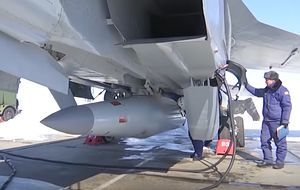The Russian government has released new footage of its “Kinzhal” air-launched missile — one of the new strategic weapons systems Russian President Vladimir Putin announced earlier this month. The missile is capable of delivering conventional and nuclear payloads and was successfully tested recently, according to the Russian Ministry of Defense.
In a short one-minute video, the Kinzhal is shown mounted under a MiG-31 interceptor aircraft. The jet takes off and is shown releasing the Kinzhal in flight, followed by brief footage of the missile’s ignition and flight.
According to the video, the Kinzhal appears to be a solid-fuel, air-launched ballistic missile, with visual similarity to Russia’s Iskander-M short-range ballistic missile, which is known for its precision and maneuverability.
During his speech to Russia’s Federal Assembly earlier this month, Putin announced the new missile. The Kinzhal was announced alongside four other strategic weapons systems and other advanced systems, including a new laser.
“The unique flight characteristics of the high-speed carrier aircraft allow the missile to be delivered to the point of discharge within minutes,” Putin said, emphasizing the Kinzhal’s promptness.
“The missile flying at a hypersonic speed, 10 times faster than the speed of sound, can also maneuver at all phases of its flight trajectory,” Putin continued.
This “also allows it to overcome all existing and, I think, prospective anti-aircraft and anti-missile defense systems, delivering nuclear and conventional warheads in a range of over 2,000 kilometers,” Putin added.
Air-launched ballistic missiles have the advantage of depriving adversaries of lower-altitude boost-phase intercept opportunities. The ability to launch the missile from high altitudes from a range of locations would also complicate midcourse interception, leaving terminal phase interception as the only realistic option.
If this missile performs like an Iskander, however, its hypersonic reentry speeds and maneuverability could stress existing terminal point defense systems, like the United States’ Patriot Advanced Capability-3 system or the Terminal High Altitude Area Defense (THAAD) systems.
The hypersonic flight claims surrounding the Kinzhal are questionable, in addition to the range claimed by Putin during his speech. The Iskander-M, which appears to be the template for this missile, is thought to have a maximum range of around 500 kilometers (to remain compliant with the Intermediate-Range Nuclear Forces Treaty).
While both the Iskander-M and the Kinzhal may reach hypersonic speeds during the final minutes of flight, in terminal phase, the Kinzhal does not appear to be capable of maneuvering during “all phases of its flight” at Mach 10 speeds, as Putin has claimed.
Moreover, it’s unclear if Russia will plan to use the MiG-31 as the primary delivery platform for this weapon. Even if the ballistic missile is capable of impressive maneuvers, the aircraft meant to deliver it is not particularly invulnerable or stealthy.

































